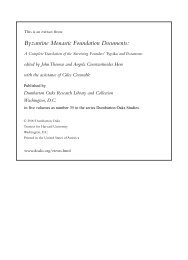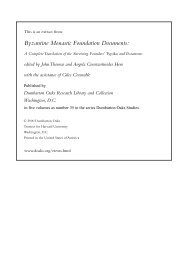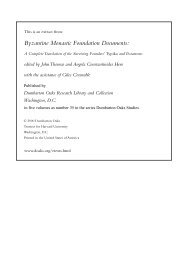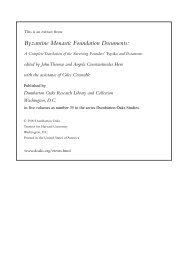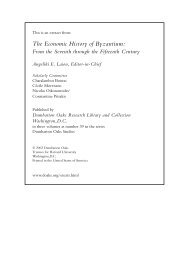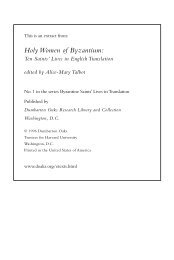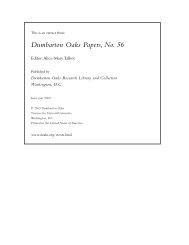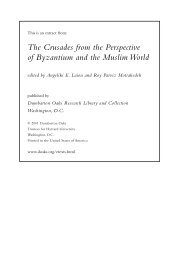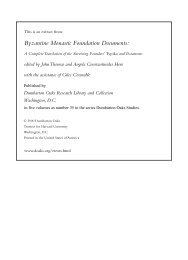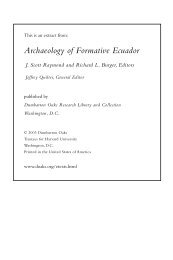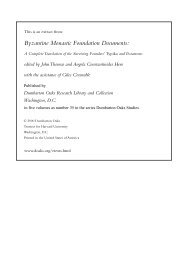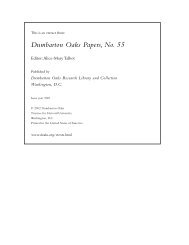Nature and Ideology: Natural Garden Design in ... - Dumbarton Oaks
Nature and Ideology: Natural Garden Design in ... - Dumbarton Oaks
Nature and Ideology: Natural Garden Design in ... - Dumbarton Oaks
Create successful ePaper yourself
Turn your PDF publications into a flip-book with our unique Google optimized e-Paper software.
The Nationalization of <strong>Nature</strong> <strong>and</strong><br />
the <strong>Natural</strong>ization of the German Nation:<br />
“Teutonic” Trends <strong>in</strong> Early Twentieth-Century<br />
L<strong>and</strong>scape <strong>Design</strong><br />
JOACHIM WOLSCHKE-BULMAHN<br />
This paper deals with the issue “<strong>Nature</strong> <strong>and</strong> <strong>Ideology</strong>” <strong>in</strong> the context of trends <strong>in</strong> German<br />
l<strong>and</strong>scape design dur<strong>in</strong>g the early twentieth century. The design of gardens <strong>and</strong> l<strong>and</strong>scapes<br />
is often considered to be an <strong>in</strong>nocuous, nonpolitical task free of ideology. One of the purposes of<br />
this study is to demonstrate the sometimes highly political <strong>and</strong> ideological character of this task<br />
<strong>and</strong> of l<strong>and</strong>scape architecture as a discipl<strong>in</strong>e. The ideological character of German l<strong>and</strong>scape<br />
design <strong>in</strong> the early twentieth century can be most clearly elucidated us<strong>in</strong>g examples of natural<br />
garden <strong>and</strong> l<strong>and</strong>scape design, show<strong>in</strong>g how a group of German l<strong>and</strong>scape architects fostered<br />
nationalism <strong>and</strong> racist ideas about society <strong>and</strong> fought an <strong>in</strong>ternational orientation with their<br />
concepts of natural garden design that were developed dur<strong>in</strong>g the early twentieth century. These<br />
concepts were <strong>in</strong>fluenced by particular ideas about the German nation <strong>and</strong> the German people<br />
<strong>and</strong> their alleged specific relationship to nature that arose <strong>in</strong> the n<strong>in</strong>eteenth century.<br />
The first part of this paper focuses on the development of such n<strong>in</strong>eteenth-century ideas<br />
about the assumed relationship between nature <strong>and</strong> the German people. These ideas <strong>and</strong> their<br />
underly<strong>in</strong>g ideology <strong>in</strong>fluenced l<strong>and</strong>scape design <strong>in</strong> the changed political <strong>and</strong> social conditions of<br />
early twentieth-century Germany. The second part illustrates how such ideas <strong>in</strong>fluenced concepts<br />
of natural l<strong>and</strong>scape design <strong>and</strong> discusses three specific sites <strong>in</strong> northern Germany: two<br />
cemeteries, the Place of the Ancestors Hilligenloh (Ahnenstätte Hilligenloh) (Fig. 1) <strong>and</strong> the<br />
Place of the Ancestors Seelenfeld (Ahnenstätte Seelenfeld) (Fig. 2); <strong>and</strong> the Grove of the Saxons<br />
(Sachsenha<strong>in</strong>), a gather<strong>in</strong>g place for He<strong>in</strong>rich Himmler’s SS near Verden on the river Aller (Fig.<br />
3). The Grove of the Saxons was designed <strong>in</strong> 1935, <strong>and</strong> the Place of the Ancestors Seelenfeld<br />
around 1930, shortly before the takeover by the Nazis; the exact date of the open<strong>in</strong>g of the<br />
I want to thank L<strong>in</strong>da Safran, of the Catholic University of America, for discuss<strong>in</strong>g several versions of this text<br />
with me.<br />
187




